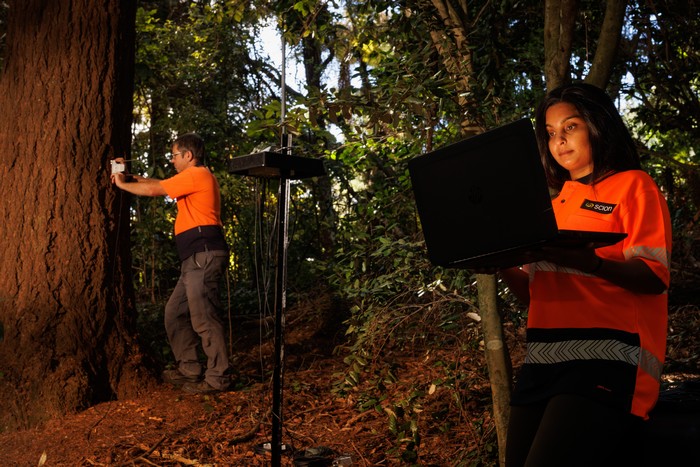Forest Flows Engagement
Understanding how water flows through the land, including planted forests, is essential to make the best use of land and water while maintaining environmental health. Forest Flows developed methods to predict water use in planted forests and water supply to downstream users, and answer the questions: Where is the water? Where is it going? And who gets to use it?
An objective of the programme was to have regular, in person engagement with our local communities so we could understand the different stakeholder views on the water and trees and provide the information they required. The programme would not have been successful without local community support and engagement.
Workshop participants included Federated Farmers, NZ Farm Foresters Association, NGOs, Iwi, Northern Regional Council, Auckland Council, Horizons Regional Council, Tararua District Council, Greater Wellington Regional Council and Ernslaw One. To ensure that the programme engaged with mana whenua meaningfully, Forest Flows held separate and multiple wananga with the Rangitāne o Tamaki nui-ā-Rua Runanga in the Tararua District, Te Hiku Collective (representing Te Rarawa, Ngāti Kuri, Te Aupōuri, and Ngāi Takato) and Ngā Puāwai Te Oneroa-a-Tōhe Wananga in Kaitaia.

Collaborators and research sites
Forest Flows has 13 research collaborators in New Zealand, Australia, Chile, the USA, and Portugal. We have been planning the nuts and bolts of the programme including identifying research sites, planning how to set up equipment, and developing workplans.
The research site set-up has been led by Scion and NIWA and over the past year we have set-up most of the primary research sites throughout Aotearoa. These sites will be the most intensively measured both on the ground and from the air. There are also five secondary sites that provide additional data to the primary sites. Two of the secondary sites are providing data and the remaining three will be completed by the end of March 2022.
We want to thank the tangata whenua, landowners, and forest managers for graciously hosting the research sites and engagement with the programme.
Although we have been focused on the set-up of the research, some of the Forest Flows teams have started their research and in some cases are ahead of schedule.
Collaborators
New Zealand-based collaborators include
International collaborators include
- Meter Group (USA)
- Virginia Tech (USA)
- University of Massachusetts (USA)
- University of Southern California (USA)
- CSIRO (Australia)
- Whitegum Forest Natural Resource (Australia)
- Moinhos de Vento Agroecology Research Centre (Portugal)
- ARAUCO (Chile)
Summit Forests NZ Limited manages Te Hiku plantation forest on land collectively owned by four Te Tai Tokerau iwi (Te Aupōuri, Ngāti Kuri, Ngāi Takoto and Te Rarawa). Summit is dedicated to managing the land in an environmentally, culturally, socially and economically sustainable manner. We welcome Scion’s research focused on flows from this forest and hope it will help plug some of the hydrological knowledge gaps. In the future the information gathered may be able to provide sound science to management decisions, particularly around wetland setbacks. - Karen Lucich, Environmental Planner, Summit Forests NZ
Community Workshops
Forest Flows ran two successful community workshops in Masterton and Dannevirke in late spring. We shared with the local communities what Forest Flows is all about and we learnt from them what questions they have about trees, forests, and water. We learnt a lot from these workshops, and I certainly enjoyed the discussions. Thank you very much to the organisers and attendees who gave up their valuable time to attend.
Forest Flows will take learnings from these and future workshops to tailor the programme findings to provide the information that is most relevant for local communities. We look forward to more workshops this year.
Ngai Tahu Forestry are pleased to partner with Scion on their research project to better understand how plantation forestry impacts the flow and quality of water both within and beyond their forest estate. This project reflects the increasing importance being placed on the protection of our natural resources and ecosystems and Ngai Tahu envisage that the information obtained through the course of this programme has the potential to enhance and strengthen their own beliefs and values with respect to the protection of the land in perpetuity. - Chris Calder, Operations Manager, Ngāi Tahu Forestry
Stakeholder engagement
Sharing knowledge, learning and insights to support understanding, application and impact
Delivering benefits for New Zealand and New Zealanders
Benefits to New Zealand
The outputs of this research will:
- Protect primary-sector productivity and improve water quality, flood mitigation, and current/future demands for rural/urban users, by quantifying water storage/release by planted forests
- Quantify the positive and negative impacts of planted forests on water resources, including any potential impacts resulting from intensification of planted-forest productivity
- Determine whether some tree species and planted forest types are better at flood mitigation than others
- Identify planted forests that have the potential to be passive water-reservoir systems and thereby reduce the number/size of irrigation schemes in their area
New Zealand’s planted forests are part of a mosaic of land cover, and the relationships between our planted forests and the flow of water in and out of them and the consequent impact on and interaction with the wider receiving environments are not always well understood. Yet water use and flow dynamics are fast becoming a major issue affecting forest owners’ licence to operate – both as a result of major rainfall events, and in increasingly dry areas. In drier areas such as Otago, regulators are starting to single out plantation forestry for land use restrictions, and this seems to be based on research that relies on a small number of sometimes quite unrepresentative studies. Scion’s Forest Flows research programme promises to significantly advance our understanding of in-forest and catchment flow dynamics, and should deliver robust modelling tools to back up the positive impact of our plantation activities. - Peter Oliver, General Manager, Forest Assets, City Forests
